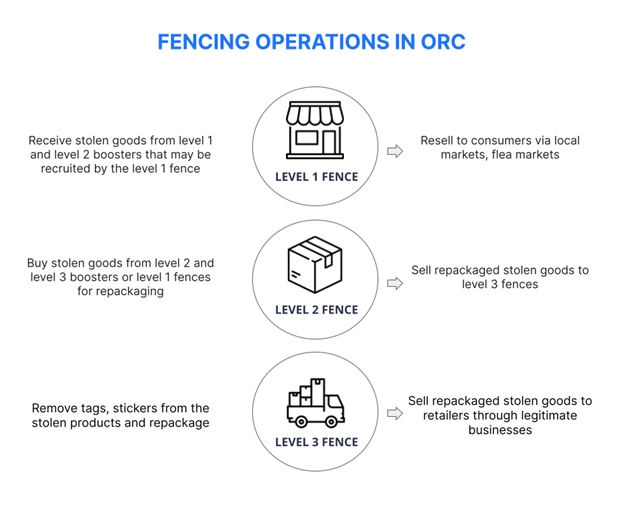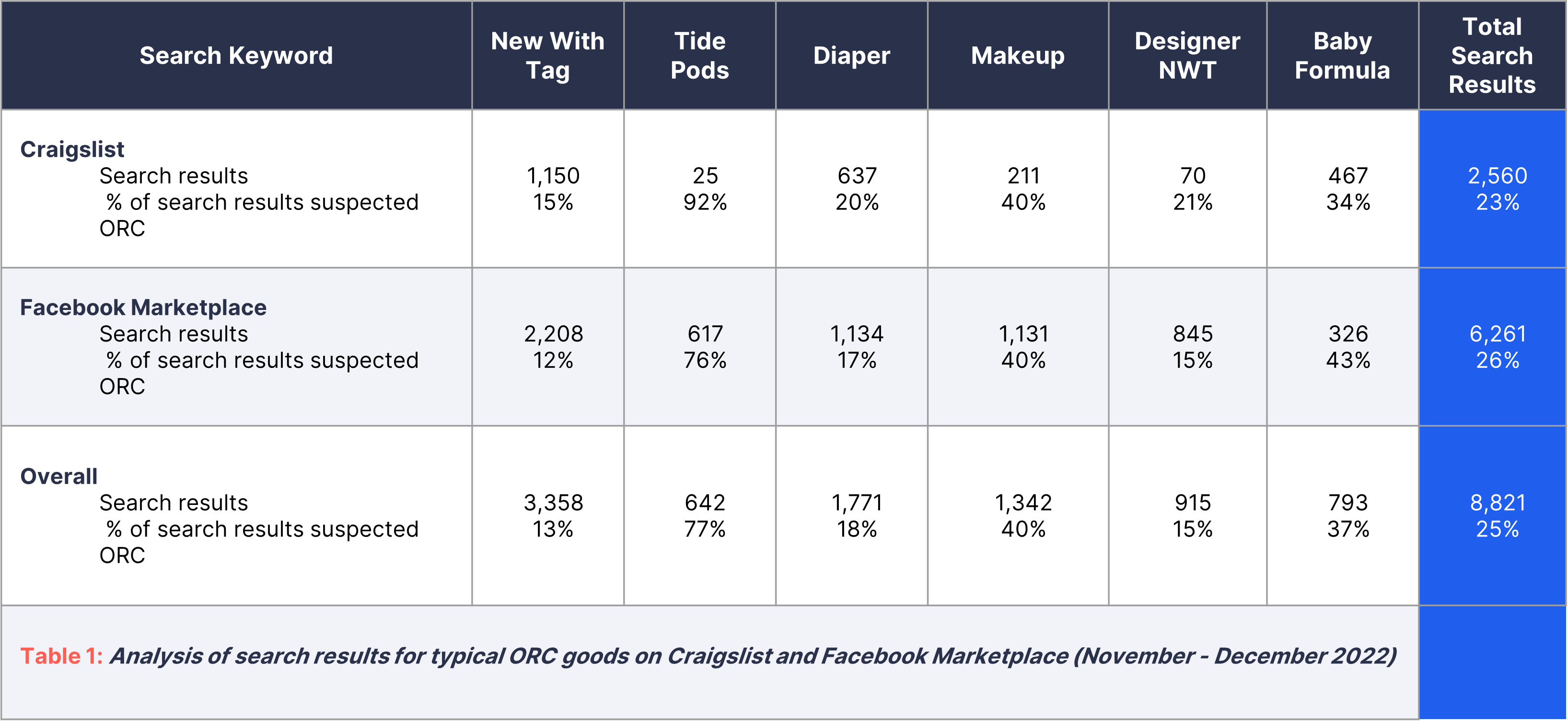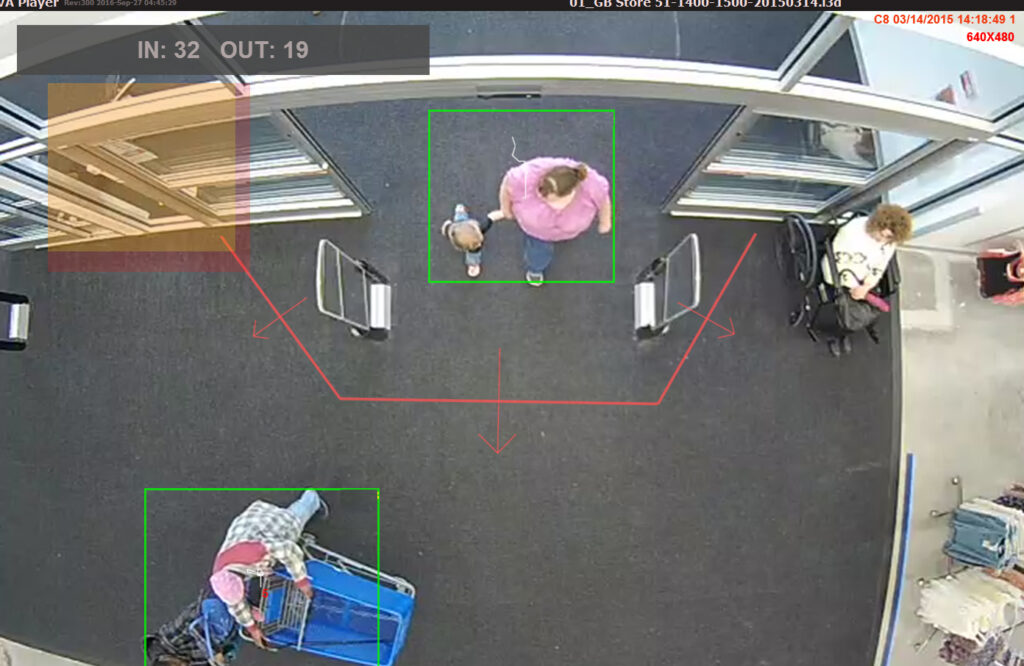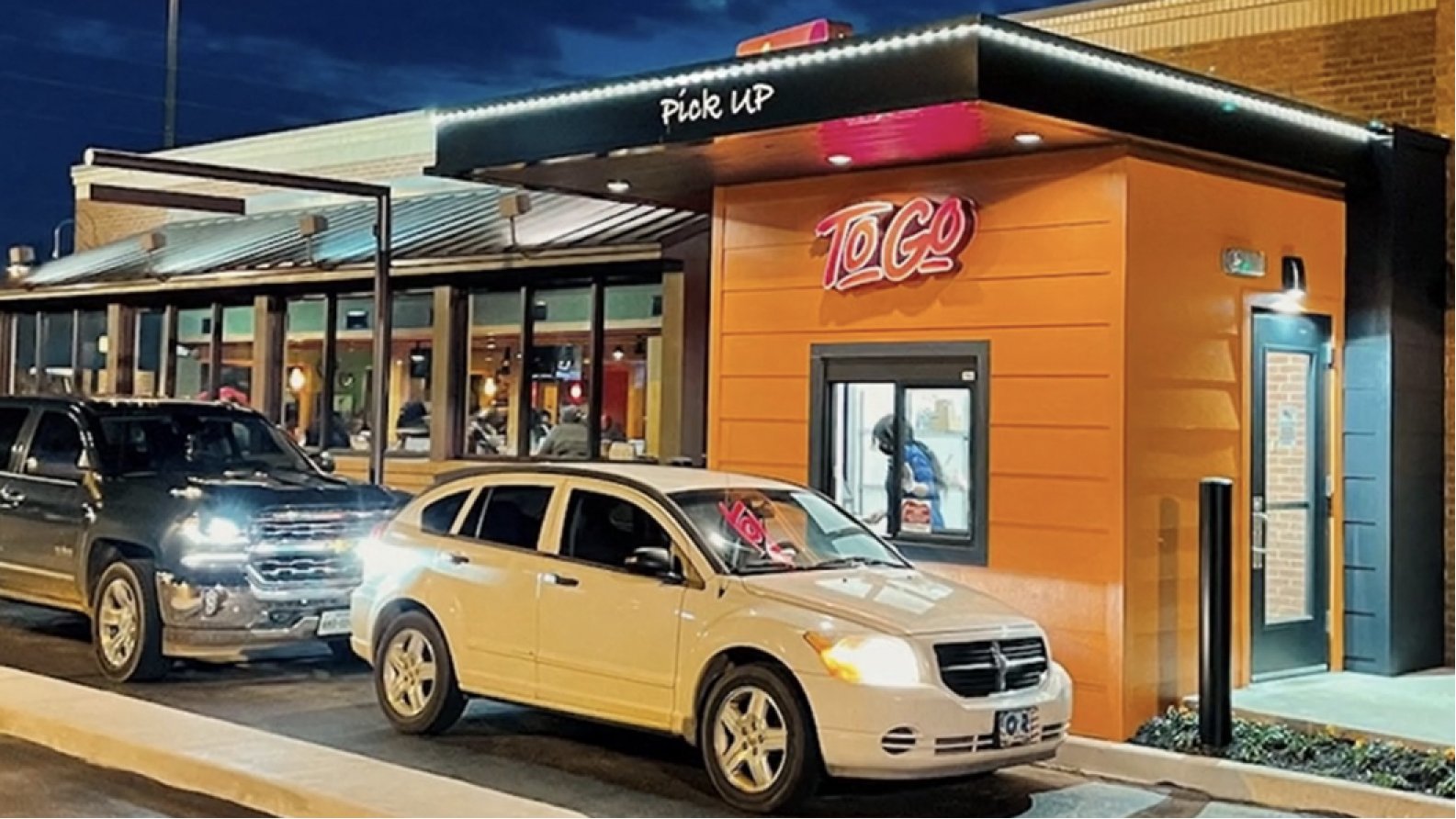Unmasking Organized Retail Crime: Strategies for Countermeasures

Senior Vice President, Customer Success

Senior Vice President, Security Monitoring Operations
Unmasking Organized Retail Crime: Strategies for Countermeasures
Share this article
According to the 2022 National Retail Security Survey, there was a 26.5% spike in ORC between 2020 and 2021 and 70% of retailers surveyed believed the threat of ORC had increased during the past five years.
Big-box retailers and large-format grocery stores are especially vulnerable to ORC gangs as most items are unsecured inside the store and the staff cannot be actively manning every corner of the store. Recently, the CEO of Target announced that ORC may contribute as much as $500 million in losses in 2023.
The impact of organized retail crime extends beyond financial losses for retailers.
Organized retail crime poses multi-dimensional threats to retail chains:
- Affects consumers through increased prices
- Poses safety risk due to stolen and tampered goods
- Imposes additional strain on an already stretched law enforcement
- Undermines the overall security and customer experience
The absence of comprehensive federal legislation specifically targeting ORC, the high cost of deploying loss prevention teams specifically to target ORC gangs, combined with the decriminalization of low-level offenses in certain states, has created an environment where the benefits of engaging in such criminal activities far outweigh the risks.
This blog post explores the factors contributing to the surge in ORC and proposes effective countermeasures to mitigate this escalating problem.
ORC refers to coordinated and premeditated criminal activities specifically targeted at retail establishments. ORC involves professional criminals or organized groups that engage in theft, fraud, or other illegal activities within the retail sector. Unlike individual shoplifting incidents, ORC typically operates on a larger scale, targeting multiple retail stores or chains.
ORC groups employ various tactics to carry out their criminal operations. These can include organized theft of merchandise, return fraud, gift card or loyalty points scams, cargo theft, counterfeiting, identity theft, and other similar activities. The stolen goods are then sold through various channels such as online marketplaces, pawn shops, or underground networks.
What distinguishes organized retail crime from individual acts of theft is the level of organization and sophistication involved. ORC groups often exhibit centralized coordination, with members specializing in specific roles within a structured hierarchy. This division of labor allows them to efficiently carry out thefts, distribute stolen goods, and launder the proceeds.
ORC gangs have well-defined organizational structures with specialized roles and responsibilities.
The source of stolen goods touches every node in the retail supply chain:
- Internal theft or pilferage from warehouses
- Cargo theft from distribution or delivery companies
- Online fraud such as identity theft
- Counterfeiting
- Flash mobs and gangs to target retail stores
- Thieves that target e-commerce deliveries at consumer residences
- Internal theft in collusion with store employees
In order to pull off a profitable ORC operation, a typical ORC gang has a clearly defined set of roles and responsibilities.
Ringleaders
ORC Ringleaders orchestrate and lead criminal activities. They recruit and organize networks of thieves to carry out these activities, coordinate operations, select targets, and devise tactics to evade store security measures. They identify new targets and establish connections with fences or illicit markets for profit. Ringleaders also plan long-term strategies and devise the modus operandi to capitalize on security vulnerabilities.
Boosters

Fences

Cleaners
Cleaners remove or alter identifying marks or security measures from stolen merchandise. Their role is to “clean” the stolen goods, making them more difficult to trace back to their original source or retailer. They do this by removing security tags, altering serial numbers or labels, repackaging items, or modifying appearance to make the stolen merchandise appear legitimate.
Money launderers
Money launderers disguise the illicit origins of funds obtained through ORC operations. They employ various methods to legitimize the illegally gained proceeds. These include cash smuggling, breaking down significant sums of cash into smaller deposits (aka “smurfing”), routing money through shell companies, invoice manipulation, or using cryptocurrencies.
Low-Risk, High-Reward Crime
“Organized retail crime is more than petty shoplifting, and the economic impact has become alarming. Professional thieves and organized criminal rings are building a business model by stealing and reselling products, increasingly online through marketplace platforms like Amazon or Facebook.”
Michael Hanson, Senior Executive Vice President of Public Affairs for the Retail Industry Leaders Association
Where there is demand, there is a “business” opportunity.
In late 2022, Roni Rubinov, an ORC gang leader operating a pawn shop in New York was caught with nearly $4 million in stolen goods from CVS and Sephora. Police in San Francisco shut down a fencing operation that made over $500K per year for the criminal involved in selling stolen over-the-counter medications and personal care products.
According to a report published by ACAMS and Homeland Security Investigations, ORC gangs cater to consumer demand for deeply discounted products across a wide range of categories using online marketplaces.
The table below from a joint report published by NRF and K2 Integrity shows the top products that are likely stolen available on Craigslist and Facebook.

Source: NRF
While there is definitely money to be made by ORC gangs, states have begun raising the threshold for felony thefts making smash-and-grab-type crimes less risky for the perpetrators.
That’s not all.
Law enforcement and state governments grappling with overcrowded prisons and budgetary cuts are taking steps to reduce intake into prisons.
According to a recent National Retail Security Survey, “the majority (70.8%) of respondents reported either a moderate increase (36.6%) or substantial increase (34.2%) in ORC case values in areas that increased felony thresholds.”
The same report also mentions that 54.6% of survey respondents reported an increase in repeat offending associated with pretrial detention and cash bail reforms.
Lack of Data and Fledgling Legislative Initiatives
One of the key reasons behind the rise of ORC is the absence of comprehensive federal legislation explicitly targeting this type of crime. Most law enforcement agencies across states do not track ORC separately. ORC crimes are clubbed with burglary, shoplifting, and theft. While there is a growing realization about the seriousness of ORC, this issue hasn’t received the attention it deserves from legislators and law enforcement yet.
Here is how the NRF summarizes the problem:
“There are significant deficiencies in the availability of consistent and consolidated data regarding ORC. The fragmentary and disorganized state of data on ORC across national, state, and local authorities, and the lack of standard centralized information on ORC from the retail industry, present difficulties in building a nuanced understanding of ORC’s national and regional prevalence, and operational trends.
The lack of quality data has stymied efforts to raise public awareness about the scale and consequences of ORC, according to a former law enforcement official, who noted that ORC presents an intelligence problem for law enforcement authorities and retailers.”
However, there seems to be a growing realization among state government and law enforcement about the ripple effects of ORC if left unchecked. Thirty-two states including states like California, Florida, Texas, and Pennsylvania that account for a big chunk of ORC and retail theft have either passed ORC legislation or are in the process of enacting one.

Source: California Legislative Information
The Combating Organized Retail Crime Act of 2023 proposes to establish a coordinated multi-agency response to tackle organized retail theft.
“Stores throughout American communities have not been spared from a national crime wave. These organized theft rings have been developing new tactics to pilfer goods, causing economic harm to American businesses and putting consumers at risk while funding transnational criminal organizations throughout the world. These criminals are exploiting the internet and online marketplaces to stay one step ahead of the law, and it’s time the law catches up. This bill improves our federal response to organized retail crime and establishes new tools to recover goods and illicit proceeds, and deter future attacks on American retailers”.
Senator Chuck Grassley
However, initiatives like these are offset by legislative setbacks. For example, a proposal to fix the loopholes in Prop 47 that raised the felony threshold in California for theft to $950 was scuttled in 2022 and never saw the light of day. In some states, the felony threshold is much higher. For example, in Texas criminals can get away with misdemeanor charges if the value of the stolen items is less than $2500.
To curb the brazen sale of stolen goods on online marketplaces, the US government passed the INFORM (The Integrity, Notification, and Fairness in Online Market Retail Marketplaces for Consumers) Act as part of the Consolidated Appropriations Act in December 2022. The new law requires high-volume, third-party sellers on online marketplaces like Amazon and eBay to submit mandatory information such as bank account numbers, government-issued identification, and contact information. In addition, online marketplaces must publish the seller’s business name, physical address, and contact information for the consumer’s benefit and offer consumers a means to flag suspicious sellers online.
However, initiatives like the INFORM Act are easy to circumvent. A vast majority of fencing operations involve using a legitimate business or a store. Organized gangs function like any other business and have the capability to overcome regulatory hurdles.
Retail Loss Prevention Gaps
By themselves, retailers cannot stamp out ORC as the issue is driven by socio-economic upheavals, legal issues, law enforcement constraints, and other challenges that retailers don’t control. However, there are several resource and technical constraints within retail organizations that create opportunities for criminals to continue their nefarious activities with impunity.
According to the 2022 Retail Security Survey, over 43% of retailers surveyed increased their loss prevention budget to spend on capital equipment. This data also highlights an important issue that loss prevention teams face, i.e. a chronic lack of high-quality security infrastructure.
Some of these gaps include:
- Legacy Security Cameras: Outdated or malfunctioning surveillance cameras that may not capture clear images or provide adequate coverage. Poor video quality can make it difficult to identify shoplifters or monitor employee behavior effectively.
- Insufficient Camera Coverage: Camera placement can result in blind spots or limited coverage making investigations challenging. Also, camera placement or its capabilities may not keep pace with store layout changes or redesign over a period of time.
- Cumbersome Video Sharing: In the absence of a centralized video management system, accessing video footage and sharing video evidence with internal stakeholders or law enforcement becomes a challenging and time-consuming process.
- Outdated Alarms: Ineffective alarm systems due to delayed maintenance cycles or outdated technologies can hurt retailers. Too many alarm vendors and non-standard alarm management protocols can result in improper alarm maintenance and difficulty for employees to keep up with diverse alarm management protocols.
- Lack of Sensor Integration: Loss prevention teams often use multiple security systems, such as CCTV cameras, alarms, access control systems, and electronic article surveillance (EAS) tags. Important alerts or suspicious activities can go unnoticed if these systems are not integrated or monitored effectively.
- Inability to Keep Up With Business Changes: COVID forced major changes to the way retailers operate. Some of the most notable shifts were a massive growth in e-commerce, BOPIS (Buy Online and Pickup in Store), and curbside services. Loss prevention teams are now stretched thin as they have to secure the stores beyond their four walls and create the technical infrastructure to tackle cybersecurity and online fraud as well.
ORC gangs not only target stores, but they also pick out security vulnerabilities in the entire supply chain right from the port. This places a significant burden on loss prevention teams as they are responsible for securing every critical point in the supply chain that’s controlled by the retailer. These include warehouses, distribution centers, and shipments to stores.
As retailers brace to fight back against ORC, their focus should be on preventing crime before it happens by implementing early detection capabilities, rolling out advanced surveillance capabilities, securing high-value merchandise, and training employees to handle external theft. All of these efforts should be backed by information sharing between retailers, field investigations, and coordination with law enforcement. A daunting challenge indeed.
No, organized retail crime (ORC) is not a victimless crime. ORC involves theft, fraud, and illegal activities targeting retailers and their customers, resulting in significant financial losses and potential harm. While the immediate victims may be the retailers who suffer from stolen merchandise, increased costs, and disrupted operations, there are broader impacts as well.
ORC can lead to higher prices for consumers as retailers attempt to recover their losses, potentially affecting individuals and communities with limited financial resources. Additionally, ORC can create an unsafe environment for employees and customers, as criminals engaged in these activities may resort to violence or other criminal acts to achieve their objectives. Furthermore, the profits generated from organized retail crime can be used to fund other illegal activities, posing risks to society as a whole.
The 2022 Retail Security Survey found that a majority of retailers surveyed (68.5%) did not have an ORC investigation team. Without investigations and intelligence sharing with law enforcement, it is impossible to pin a crime on an ORC gang. The only way forward for retailers would be to eventually invest in building an ORC investigation unit.
So how should a retailer go about setting up an ORC investigation unit?
Review ORC Capabilities to Address Gaps
The most important requirement for setting up an ORC investigative unit will be a clear management mandate and budgetary support to make it happen.
Assuming there is a consensus to get the ball rolling, the first step in setting up an ORC investigative unit is to evaluate the current capabilities of the loss prevention and asset protection teams.
Key factors to consider during the evaluation include:
- Availability of investigative talent that can be nurtured to spearhead the ORC investigation team.
- Historical data on theft and crime, results of past investigations by law enforcement, details of the perpetrators, and possible patterns or correlations.
- Availability of training material and a policy to encourage employees to get certified.
- Availability of technology platforms needed to access security events, conduct OSINT (Open Source Investigations), and share data internally and with law enforcement to coordinate apprehension and recovery.
Train the ORC Investigation Team
Loss prevention teams are trained to operate within the four walls of the store and apprehend a criminal before they leave the store. However, ORC investigations require a completely new set of investigative skills and an ability to operate outside the store. That’s why a multi-dimensional training program is needed to equip the ORC investigation teams with the skills they need to succeed.
The scope of the training program can include:
- Investigative Techniques and Tools: Conducting online investigations, utilizing open-source intelligence (OSINT) tools and techniques, field surveillance techniques, gathering and analyzing digital evidence
- Identifying and Documenting ORC Crimes: Recognizing common ORC methods and patterns, identifying and documenting stolen merchandise, analyzing financial transactions and patterns, creating effective case reports and documentation
- Collaboration and Information Sharing: Building relationships with law enforcement agencies, establishing partnerships with other retailers, sharing information and best practices within the team and industry
- Coordinating with Law Enforcement: Understanding law enforcement procedures and protocols, presenting evidence, and working towards successful prosecutions
- Understanding Legal Matters: Overview of relevant laws and regulations related to ORC, legal procedures for conducting investigations, privacy considerations
- Physical Security and Loss Prevention: Store layout and security considerations, effective use of CCTV cameras and other security measures, strategies for preventing and deterring ORC activities
- Crisis Management and Response: Developing an emergency response plan, handling high-risk situations and incidents, and coordinating with internal and external stakeholders during crises
What Are the Roles & Responsibilities of an ORC Investigator?
- Initiate, conduct, and manage ORC investigations, utilizing field tactics and surveillance techniques to gather intelligence and determine the scope of the investigation.
- Utilize data analysis tools and exception reporting to identify potential ORC theft and fraud issues impacting company assets.
- Collaborate with the ORC Analyst to review POS and non-POS exception reports for identifying and linking organized retail crime activities.
- Prepare detailed investigative plans and maintain accurate documentation of investigations in the case management system.
- Work closely with law enforcement agencies, providing intelligence and evidence to support successful prosecutions.
- Develop and maintain positive relationships with internal teams, including AP, supply chain, and e-commerce, to coordinate investigations and drive theft and fraud elimination efforts.
- Represent the company at conferences, ORC meetings, and other industry events.
- Stay updated on nationwide ORC patterns and trends, bringing insights to the team and implementing relevant training and programs.
- Collaborate with state, local, and federal law enforcement agencies, participating in interviews, search warrants, and surveillance operations.
- Engage with local and state government entities, retailers, and industry organizations to advocate for and support ORC legislation.
Implement Technologies and Tools
Utilizing robust processes and cutting-edge technologies can significantly enhance your ability to detect, prevent, and respond to ORC incidents. Some of the critical tools or infrastructure needed to accelerate ORC investigations and successfully recover stolen goods include:
- Video Surveillance Systems: Implement a high-quality video surveillance system at your retail locations, distribution centers, or warehouses to capture evidence of ORC activities. This can include IP cameras, video analytics software, and centralized monitoring stations.
- Case Management System: Case management systems can be used to track and manage investigations, store case-related documents and evidence, and facilitate collaboration among team members. Vendors include Agilence and ThinkLP.
- Digital Forensics Tools: Invest in digital forensics software and hardware tools that extract, analyze, and preserve digital evidence from various sources, such as computers, smartphones, and surveillance systems. Vendors include Cellebrite and Magnet Forensics.
- Open-Source Intelligence (OSINT) Tools: OSINT tools enable your investigators to gather information from publicly available sources online. Examples include social media monitoring tools, web scraping tools, and online database search platforms. Vendors include Flashpoint and LifeRaft.
- RFID Solutions: Upgrade RFID for Electronic Article Surveillance (EAS) to add Electronic Product Code (EPC) capabilities along with video integration to not only track the product but also capture the faces of people who may be conducting a smash-and-grab job. With EPC capabilities, any fencing investigation on the field can be expedited with handheld EPC RFID tag readers.
- Data Analytics and Pattern Recognition Tools: Utilize data analytics tools to identify patterns, trends, and anomalies in sales data, financial transactions, and inventory management. These tools can help detect potential ORC activities and provide insights for investigations. For example, POS exception reporting solution from Interface can detect anomalies in sales data.
Collaborate & Share Information
To effectively combat ORC, retailers must establish partnerships with industry associations, law enforcement agencies, and other relevant stakeholders. Collaboration facilitates the exchange of intelligence, best practices, and emerging trends, enabling a proactive response to the evolving nature of ORC.
ORC Databases: Retailers can work together to create ORC databases that track known offenders, stolen merchandise descriptions, and patterns of criminal activity. Sharing this information among retailers helps identify trends, patterns, and individuals involved in ORC, allowing for better prevention and faster response. Industry associations can play a crucial role in facilitating such information-sharing platforms and fostering collaboration among retailers.
Partnership with Law Enforcement:Close collaboration with law enforcement agencies is vital. Retailers can establish direct lines of communication with local police departments and establish a protocol for reporting ORC incidents promptly. By sharing surveillance footage, suspect descriptions, and other relevant evidence, retailers can assist law enforcement in their investigations and increase the likelihood of arrests and successful prosecutions.
Training Store Associates: Education and awareness play a pivotal role in preventing ORC incidents. Retail employees should receive comprehensive training on recognizing ORC indicators, understanding theft patterns, and implementing effective prevention techniques. Training programs should include topics such as identifying common ORC tactics, customer engagement strategies, and the importance of accurate documentation and reporting. By equipping employees with the necessary knowledge and skills, retailers empower their staff to play an active role in preventing ORC incidents and protecting the business.
Workshops: Additionally, retailers can conduct regular workshops and seminars involving law enforcement experts and loss prevention specialists. These sessions can provide updates on the latest ORC trends, best practices in security measures, and insights into the modus operandi of organized retail crime groups.
List of Anti-ORC Associations in the US
Stopping an ORC theft before it happens and ensuring sufficient evidence is recorded when it happens can dramatically improve a retailer’s ability to minimize the negative impact of ORC
AI-Enabled Cameras
AI-enabled cameras can detect suspicious behaviors, such as unusual movements, repeated visits to high-value merchandise areas, or sudden large group gatherings. This real-time monitoring can also be designed to trigger alerts when suspicious behaviors are detected enabling onsite or remote security teams to take steps to minimize loss and keep customers away from harm’s way.

License Plate Recognition
In addition to AI-enabled cameras, Automatic License Plate Readers (ALPR) can be installed in parking lots and entrances to track vehicles and flag those associated with past ORC activities. These systems capture license plate information and compare it against a database of known offenders, alerting security personnel when a vehicle of interest is detected.
Facial Recognition
Autonomous and Automated Voice-Down

Automated voice-down (AVDs) announcements can convey a constant security presence, increasing the perceived risk for “boosters” (ORC street-level thieves). AVDs can be designed to function autonomously by leveraging AI-enabled cameras that can detect the presence of people or vehicles with 99.99% reliability.
These announcements can include messages like “Attention, shoplifters will be prosecuted to the fullest extent of the law” or “This store is equipped with advanced surveillance systems.
Think twice before committing a crime.” AVDs can be integrated with strobes, lights, access control systems, alarm systems, and remote command centers to trigger proactive security measures or alert staff and remote security professionals monitoring the site.
Interactive Monitoring
Interactive remote monitoring that leverages cameras, microphones, and speakers allows virtual security professionals operating from remote command centers to conduct virtual walkthroughs, evict loiterers, issue voice-downs to warn people who may be acting suspiciously, and interact with store employees directly as needed. This model offers discreet security coverage and an upgraded “eye on the sky” that can not only see but also interact in real-time.
To further enhance security, retailers can implement measures such as improved lighting in parking lots, clear signage indicating active surveillance, and store design that’s free of hidden sections or aisles. These visible security measures not only act as a deterrent but also provide reassurance to customers, creating a safer shopping environment.
Interface’s virtual security guard, intelligent voice-downs, and personal protection monitoring solutions can level up store security to fight the bad guys.
While the broad approach that most retailers take to combat ORC involves setting up specialized investigations teams, some retailers have taken a different path.
Victoria’s Secret never set up a separate team to spearhead ORC investigations and instead trained its asset protection (AP) associates at all locations to tackle ORC crimes. This approach eliminates potential coordination issues between ORC teams and AP teams, an opportunity for AP team members to develop their skills, and a tighter relationship with local law enforcement.
While retailers may choose distinctly different approaches to take on ORC, there is now an overwhelming realization that ORC poses a significant threat to the retail industry, affecting businesses, consumers, and communities at large. By understanding the factors contributing to the rise of ORC, adopting proactive security strategies, and collaborating with industry leaders and law enforcement, retailers can mitigate the impact of this criminal activity.
Contents
About the authors

Sean Foley
Chief Revenue Officer

Bud Homeyer
Chief Operations Officer
Explore more blog articles

Business Video Surveillance Insights for Loss Prevention Teams

7 Groundbreaking Drive-Thru Concepts and Trends for QSRs in 2024
